SKODA OCTAVIA TOUR 2009 1.G / (1U) Owner's Manual
Manufacturer: SKODA, Model Year: 2009, Model line: OCTAVIA TOUR, Model: SKODA OCTAVIA TOUR 2009 1.G / (1U)Pages: 226, PDF Size: 13.11 MB
Page 191 of 226
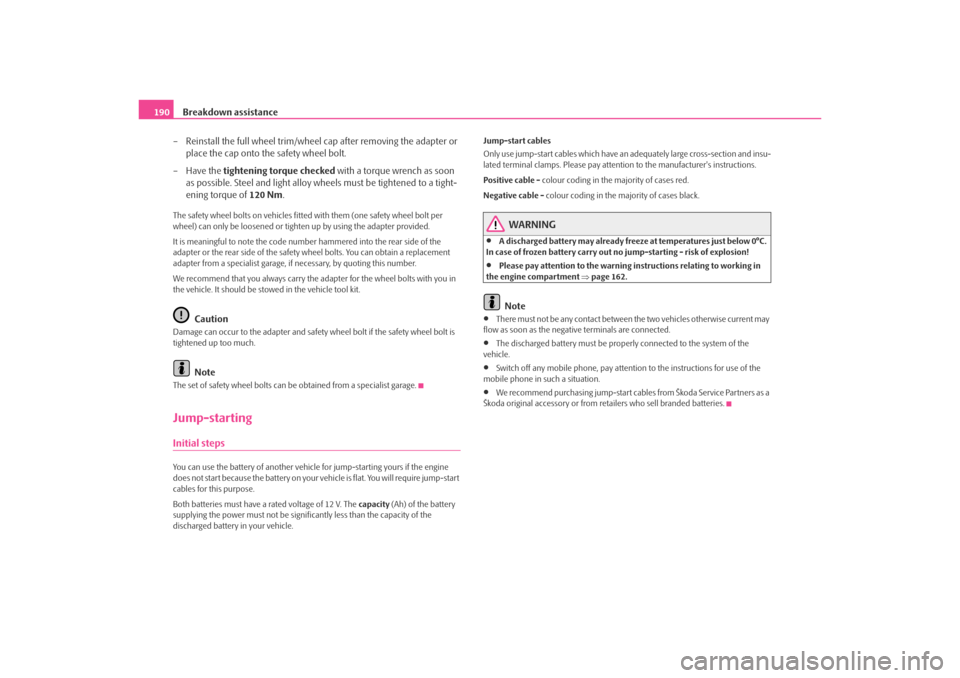
Breakdown assistance
190
– Reinstall the full wheel trim/wheel cap after removing the adapter or place the cap onto the safety wheel bolt.
– Have the tightening torque checked with a torque wrench as soon
as possible. Steel and light alloy wh eels must be tightened to a tight-
ening torque of 120 Nm.The safety wheel bolts on vehicles fitted with them (one safety wheel bolt per
wheel) can only be loosened or tigh ten up by using the adapter provided.
It is meaningful to note the code numbe r hammered into the rear side of the
adapter or the rear side of the safety wheel bolts. You can obtain a replacement
adapter from a specialist garage, if necessary, by quoting this number.
We recommend that you always carry the adapter for the wheel bolts with you in
the vehicle. It should be st owed in the vehicle tool kit.
Caution
Damage can occur to the adapter and safety wheel bolt if the safety wheel bolt is
tightened up too much.
Note
The set of safety wheel bolts can be obtained from a specialist garage.Jump-startingInitial stepsYou can use the battery of another vehicl e for jump-starting yours if the engine
does not start because the battery on your vehicle is flat. You will require jump-start
cables for this purpose.
Both batteries must have a rated voltage of 12 V. The capacity (Ah) of the battery
supplying the power must not be significa ntly less than the capacity of the
discharged battery in your vehicle. Jump-start cables
Only use jump-start cables which have an
adequately large cross-section and insu-
lated terminal clamps. Please pay attent ion to the manufacturer's instructions.
Positive cable - colour coding in the majority of cases red.
Negative cable - colour coding in the majority of cases black.
WARNING
•
A discharged battery may already freeze at temperatures just below 0°C.
In case of frozen battery carry out no jump-starting - risk of explosion!
•
Please pay attention to the warning instructions relating to working in
the engine compartment ⇒page 162.Note
•
There must not be any contact between the two vehicles otherwise current may
flow as soon as the negative terminals are connected.
•
The discharged battery must be properly connected to the system of the
vehicle.
•
Switch off any mobile phone, pay attent ion to the instructions for use of the
mobile phone in such a situation.
•
We recommend purchasing jump-start cabl es from Škoda Service Partners as a
Škoda original accessory or from retailers who sell branded batteries.
s2ig.book Page 190 Monday, November 10, 2008 11:20 AM
Page 192 of 226
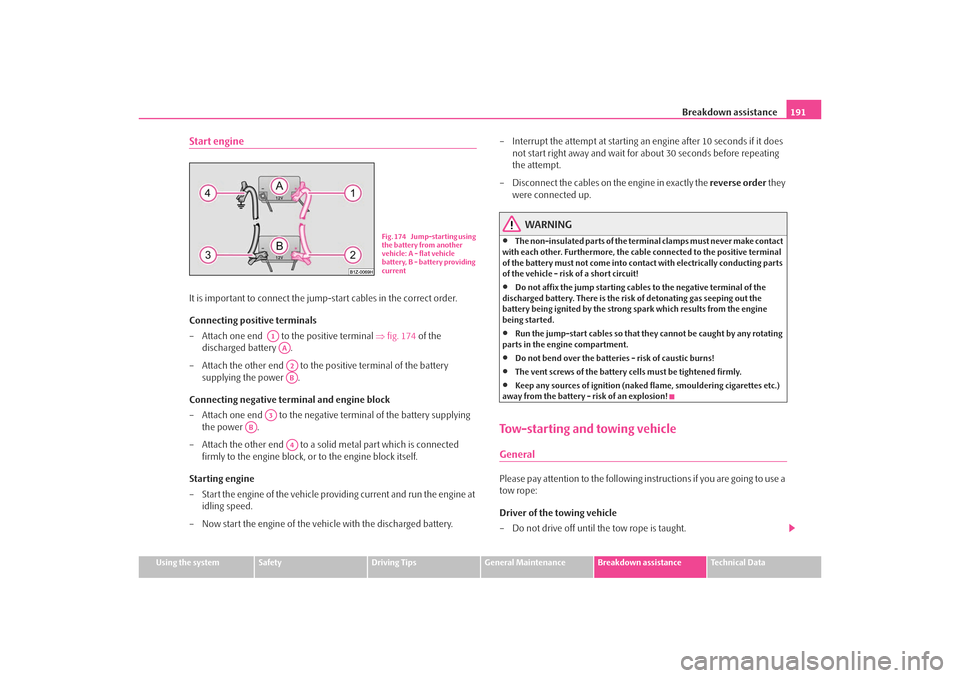
Breakdown assistance191
Using the system
Safety
Driving Tips
General Maintenance
Breakdown assistance
Technical Data
Start engineIt is important to connect the jump -start cables in the correct order.
Connecting positive terminals
– Attach one end to the positive terminal ⇒fig. 174 of the
discharged battery .
– Attach the other end to the positive terminal of the battery supplying the power .
Connecting negative term inal and engine block
– Attach one end to the negative terminal of the battery supplying
the power .
– Attach the other end to a solid metal part which is connected firmly to the engine block, or to the engine block itself.
Starting engine
– Start the engine of the vehicle providing current and run the engine at idling speed.
– Now start the engine of the vehicle with the discharged battery. – Interrupt the attempt at starting an engine after 10 seconds if it does
not start right away and wait for about 30 seconds before repeating
the attempt.
– Disconnect the cables on the engine in exactly the reverse order they
were connected up.
WARNING
•
The non-insulated parts of the terminal clamps must never make contact
with each other. Furthermore, the cable connected to the positive terminal
of the battery must not come into contact with electrically conducting parts
of the vehicle - risk of a short circuit!
•
Do not affix the jump starting cables to the negative terminal of the
discharged battery. There is the risk of detonating gas seeping out the
battery being ignited by the strong spark which results from the engine
being started.
•
Run the jump-start cables so that th ey cannot be caught by any rotating
parts in the engine compartment.
•
Do not bend over the batteries - risk of caustic burns!
•
The vent screws of the battery cells must be tightened firmly.
•
Keep any sources of ignition (naked flame, smouldering cigarettes etc.)
away from the battery - risk of an explosion!
Tow-starting and towing vehicleGeneralPlease pay attention to the following in structions if you are going to use a
tow rope:
Driver of the towing vehicle
– Do not drive off until the tow rope is taught.
Fig. 174 Jump-starting using
the battery from another
vehicle: A - flat vehicle
battery, B - battery providing
current
A1AAA2AB
A3
AB
A4
s2ig.book Page 191 Monday, November 10, 2008 11:20 AM
Page 193 of 226
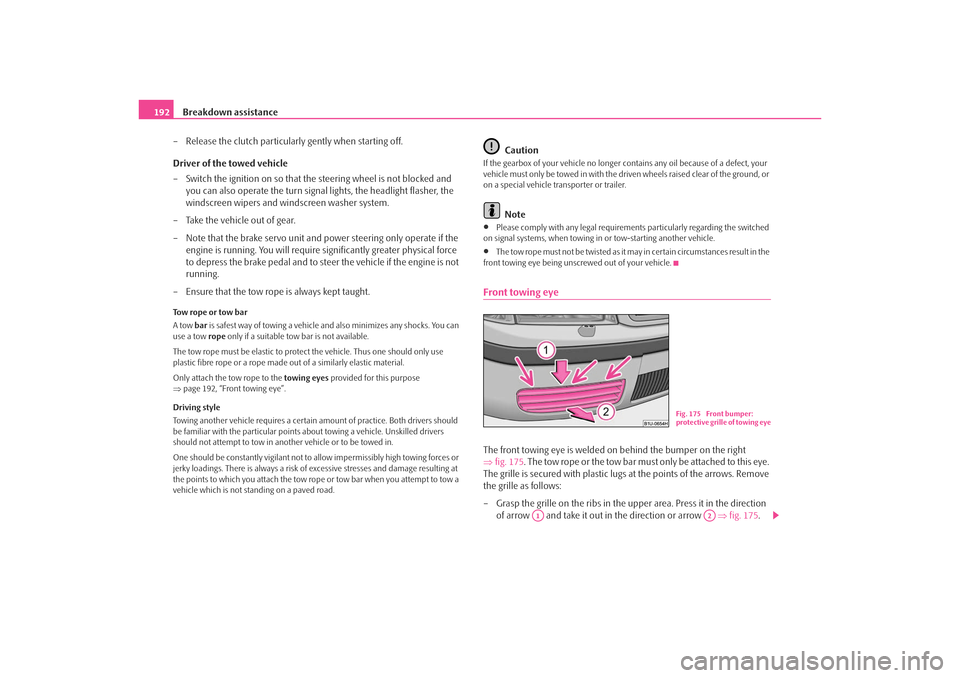
Breakdown assistance
192
– Release the clutch particular ly gently when starting off.
Driver of the towed vehicle
– Switch the ignition on so that the steering wheel is not blocked and you can also operate the turn signal lights, the headlight flasher, the
windscreen wipers and wi ndscreen washer system.
– Take the vehicle out of gear.
– Note that the brake servo unit and power steering only operate if the engine is running. You will require si gnificantly greater physical force
to depress the brake pedal and to steer the vehicle if the engine is not
running.
– Ensure that the tow rope is always kept taught.Tow rope or tow bar
A tow bar is safest way of towing a vehicle and also minimizes any shocks. You can
use a tow rope only if a suitable tow bar is not available.
The tow rope must be elastic to protect the vehicle. Thus one should only use
plastic fibre rope or a rope made out of a similarly elastic material.
Only attach the tow rope to the towing eyes provided for this purpose
⇒ page 192, “Front towing eye”.
Driving style
Towing another vehicle requires a certain amount of practice. Both drivers should
be familiar with the particular points about towing a vehicle. Unskilled drivers
should not attempt to tow in another vehicle or to be towed in.
One should be constantly vigilant not to allow impermissibly high towing forces or
jerky loadings. There is always a risk of excessive stresses and damage resulting at
the points to which you attach the tow ro pe or tow bar when you attempt to tow a
vehicle which is not standing on a paved road.
Caution
If the gearbox of your vehicle no longer contains any oil because of a defect, your
vehicle must only be towed in with the driven wheels raised clear of the ground, or
on a special vehicle transporter or trailer.
Note
•
Please comply with any legal requirements particularly regarding the switched
on signal systems, when towing in or tow-starting another vehicle.
•
The tow rope must not be twisted as it may in certain circumstances result in the
front towing eye being unscrewed out of your vehicle.
Front towing eyeThe front towing eye is welded on behind the bumper on the right
⇒ fig. 175 . The tow rope or the tow bar must only be attached to this eye.
The grille is secured with plastic lugs at the points of the arrows. Remove
the grille as follows:
– Grasp the grille on the ribs in the upper area. Press it in the direction of arrow and take it out in the direction or arrow ⇒ fig. 175.
Fig. 175 Front bumper:
protective grille of towing eye
A1
A2
s2ig.book Page 192 Monday, November 10, 2008 11:20 AM
Page 194 of 226
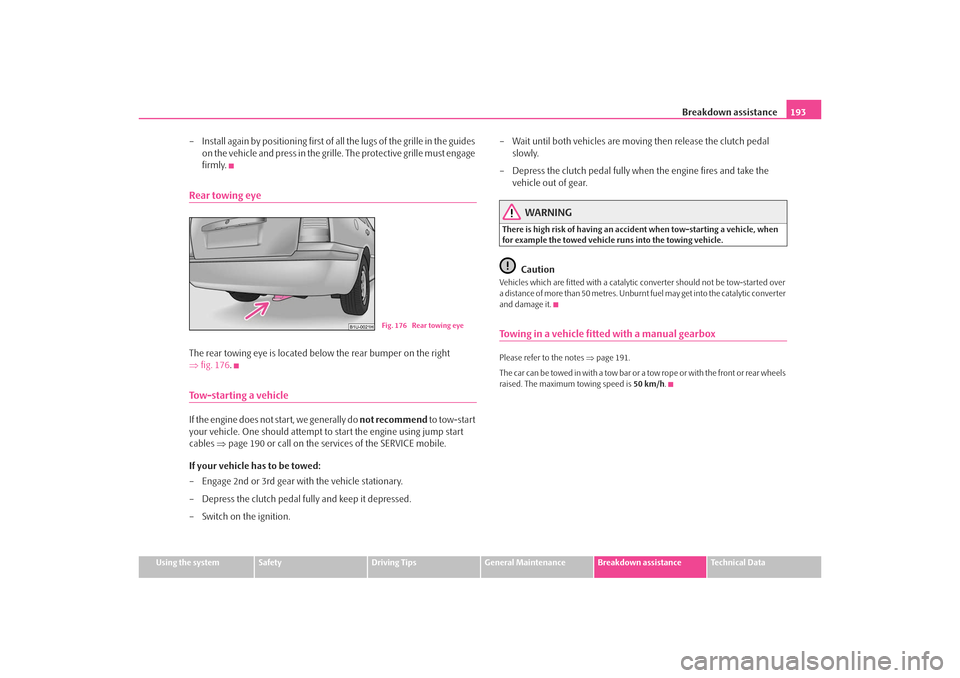
Breakdown assistance193
Using the system
Safety
Driving Tips
General Maintenance
Breakdown assistance
Technical Data
– Install again by positioning first of all the lugs of the grille in the guides
on the vehicle and press in the grille. The protective grille must engage
firmly.Rear towing eyeThe rear towing eye is located be low the rear bumper on the right
⇒ fig. 176 .Tow-starting a vehicleIf the engine does not start, we generally do not recommend to tow-start
your vehicle. One should attempt to start the engine using jump start
cables ⇒ page 190 or call on the servic es of the SERVICE mobile.
If your vehicle has to be towed:
– Engage 2nd or 3rd gear with the vehicle stationary.
– Depress the clutch pedal fully and keep it depressed.
– Switch on the ignition. – Wait until both vehicles are movi
ng then release the clutch pedal
slowly.
– Depress the clutch pedal fully when the engine fires and take the vehicle out of gear.
WARNING
There is high risk of having an accident when tow-starting a vehicle, when
for example the towed vehicle runs into the towing vehicle.
Caution
Vehicles which are fitted with a catalytic converter should not be tow-started over
a distance of more than 50 metres. Unburn t fuel may get into the catalytic converter
and damage it.Towing in a vehicle fitted with a manual gearboxPlease refer to the notes ⇒ page 191.
The car can be towed in with a tow bar or a tow rope or with the front or rear wheels
raised. The maximum towing speed is 50 km/h.
Fig. 176 Rear towing eye
s2ig.book Page 193 Monday, November 10, 2008 11:20 AM
Page 195 of 226
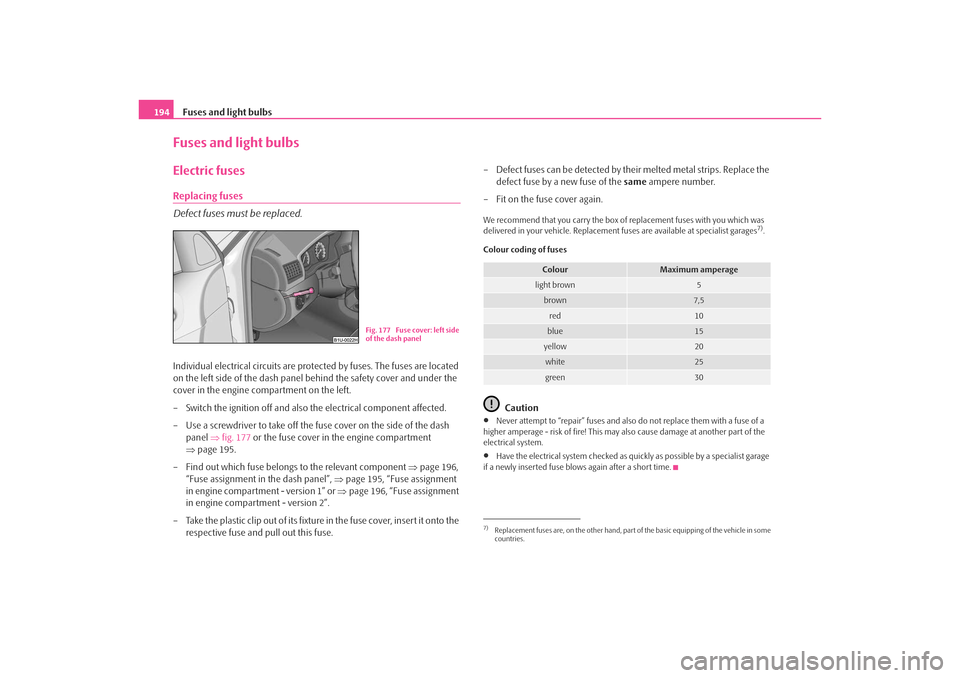
Fuses and light bulbs
194Fuses and light bulbsElectric fusesReplacing fuses
Defect fuses must be replaced.Individual electrical circuits are prot ected by fuses. The fuses are located
on the left side of the dash panel behind the safety cover and under the
cover in the engine compartment on the left.
– Switch the ignition off and also the electrical component affected.
– Use a screwdriver to take off the fuse cover on the side of the dash panel ⇒fig. 177 or the fuse cover in the engine compartment
⇒ page 195.
– Find out which fuse belongs to the relevant component ⇒page 196,
“Fuse assignment in the dash panel”, ⇒page 195, “Fuse assignment
in engine compartment - version 1” or ⇒page 196, “Fuse assignment
in engine compartment - version 2”.
– Take the plastic clip out of its fixture in the fuse cover, insert it onto the respective fuse and pull out this fuse. – Defect fuses can be detected by th
eir melted metal strips. Replace the
defect fuse by a new fuse of the same ampere number.
– Fit on the fuse cover again.
We recommend that you carry the box of replacement fuses with you which was
delivered in your vehicle. Replacement fu ses are available at specialist garages
7).
Colour coding of fuses
Caution
•
Never attempt to “repair” fuses and also do not replace them with a fuse of a
higher amperage - risk of fire! This may also cause damage at another part of the
electrical system.
•
Have the electrical system checked as quickly as possible by a specialist garage
if a newly inserted fuse blows again after a short time.
Fig. 177 Fuse cover: left side
of the dash panel
7)Replacement fuses are, on the other hand, part of the basic equipping of the vehicle in some
countries.
Colour
Maximum amperage
light brown
5
brown
7,5
red
10
blue
15
yellow
20
white
25
green
30
s2ig.book Page 194 Monday, November 10, 2008 11:20 AM
Page 196 of 226

Fuses and light bulbs195
Using the system
Safety
Driving Tips
General Maintenance
Breakdown assistance
Technical Data
Fuse cover in engine compartment
The fuse box in the engine comp artment exists in two different
versions. You can determine which version your vehicle is fitted with
after removing the fuse cover at the location of the fuses.On some vehicles, the battery cover must be removed before removing
the fuse cover ⇒page 170.
Open fuse cover
– Press the interlocks on the sides of the fuse cover in direction of arrow ⇒ fig. 178 and fold the cover in direction of arrow .
Close fuse cover
– Closing the fuse cover takes place in the reverse order.
Fuse assignment in engine compartment - version 1Certain electrical components are only standard on certain vehicle model versions
or only suppliable as optional equipment for certain models.
Fig. 178 Battery cover in the
engine compartment
AA
AB
No.
Power consumer
Amperes
1
Pump for ABS
30
2
Valves for ABS
30
3
Radiator fan 1st stage
30
4
Glow plugs for heating the coolant, relay for secondary
air pump
50
5
Engine control unit
50
6
Radiator fan 2nd stage
40
7
Main fuse of the interior
110
8
Dynamo
110 / 150
a)
a)Depending on the engine type and equipment
Fig. 179 Schematic repre-
sentation of fuse box in
engine compartment -
version 1
s2ig.book Page 195 Monday, November 10, 2008 11:20 AM
Page 197 of 226
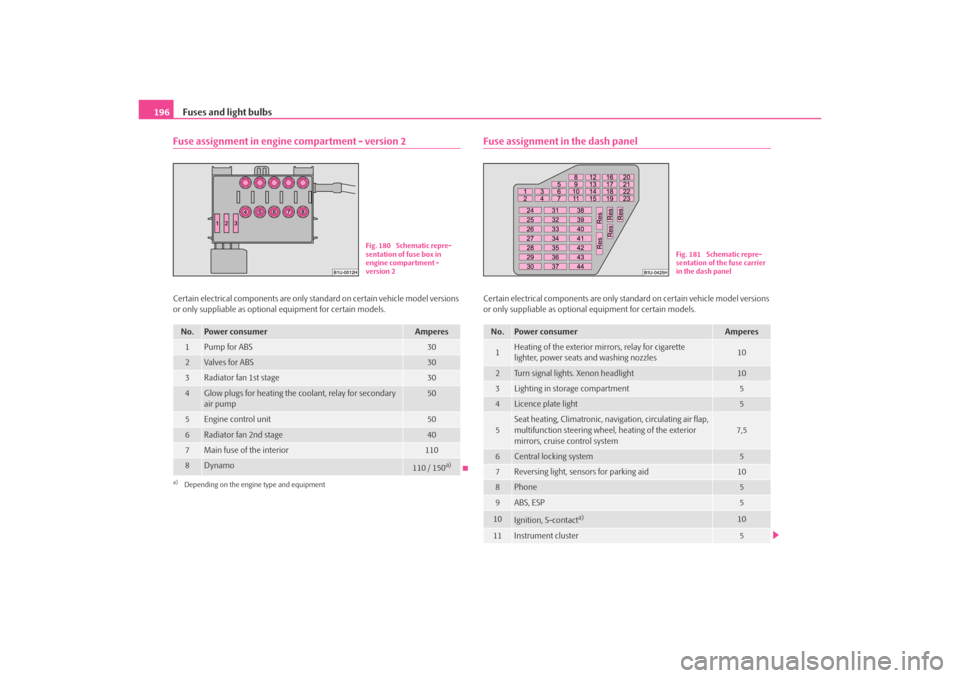
Fuses and light bulbs
196Fuse assignment in engine compartment - version 2Certain electrical components are only st andard on certain vehicle model versions
or only suppliable as optional equipment for certain models.
Fuse assignment in the dash panelCertain electrical components are only standard on certain vehicle model versions
or only suppliable as optional equipment for certain models.
No.
Power consumer
Amperes
1
Pump for ABS
30
2
Valves for ABS
30
3
Radiator fan 1st stage
30
4
Glow plugs for heating the coolant, relay for secondary
air pump
50
5
Engine control unit
50
6
Radiator fan 2nd stage
40
7
Main fuse of the interior
110
8
Dynamo
110 / 150
a)
a)Depending on the engine type and equipment
Fig. 180 Schematic repre-
sentation of fuse box in
engine compartment -
version 2
No.
Power consumer
Amperes
1
Heating of the exterior mirrors, relay for cigarette
lighter, power seats and washing nozzles
10
2
Turn signal lights. Xenon headlight
10
3
Lighting in storage compartment
5
4
Licence plate light
5
5
Seat heating, Climatronic, navigation, circulating air flap,
multifunction steering wheel, heating of the exterior
mirrors, cruise control system
7,5
6
Central locking system
5
7
Reversing light, sensors for parking aid
10
8
Phone
5
9
ABS, ESP
5
10
Ignition, S-contact
a)
10
11
Instrument cluster
5
Fig. 181 Schematic repre-
sentation of the fuse carrier
in the dash panel
s2ig.book Page 196 Monday, November 10, 2008 11:20 AM
Page 198 of 226
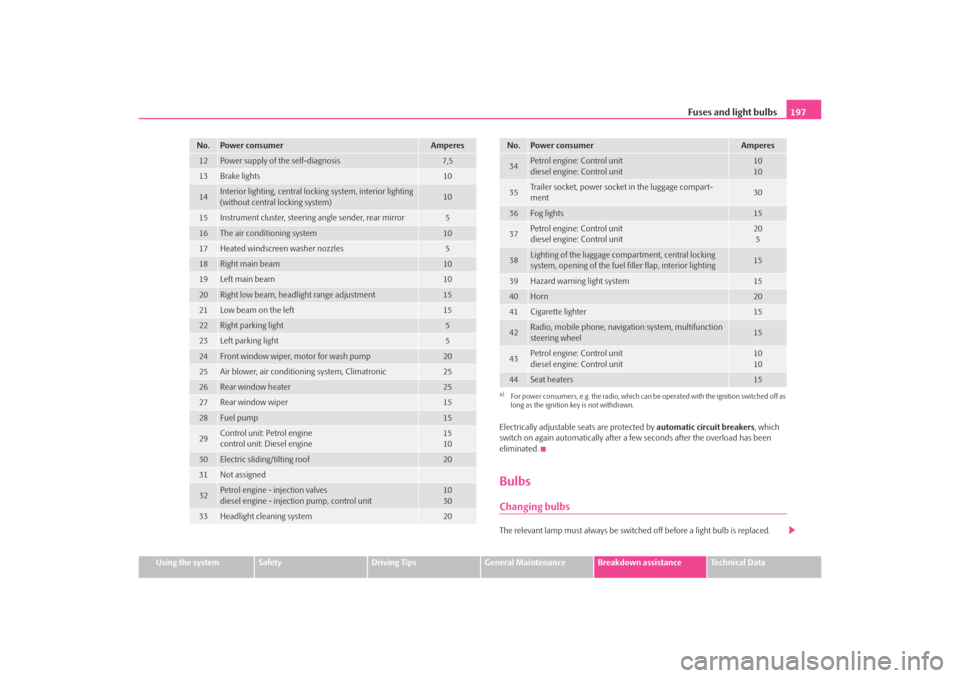
Fuses and light bulbs197
Using the system
Safety
Driving Tips
General Maintenance
Breakdown assistance
Technical Data
Electrically adjustable
seats are protected by automatic circuit breakers , which
switch on again automatically after a fe w seconds after the overload has been
eliminated.
BulbsChanging bulbsThe relevant lamp must always be switched off before a light bulb is replaced.
12
Power supply of the self-diagnosis
7,5
13
Brake lights
10
14
Interior lighting, central lockin g system, interior lighting
(without central locking system)
10
15
Instrument cluster, steering angle sender, rear mirror
5
16
The air conditioning system
10
17
Heated windscreen washer nozzles
5
18
Right main beam
10
19
Left main beam
10
20
Right low beam, headlight range adjustment
15
21
Low beam on the left
15
22
Right parking light
5
23
Left parking light
5
24
Front window wiper, motor for wash pump
20
25
Air blower, air conditioning system, Climatronic
25
26
Rear window heater
25
27
Rear window wiper
15
28
Fuel pump
15
29
Control unit: Petrol engine
control unit: Diesel engine
15
10
30
Electric sliding/tilting roof
20
31
Not assigned
32
Petrol engine - injection valves
diesel engine - injection pump, control unit
10
30
33
Headlight cleaning system
20
No.
Power consumer
Amperes
34
Petrol engine: Control unit
diesel engine: Control unit
10
10
35
Trailer socket, power socket in the luggage compart-
ment
30
36
Fog lights
15
37
Petrol engine: Control unit
diesel engine: Control unit
20
5
38
Lighting of the luggage compartment, central locking
system, opening of the fuel filler flap, interior lighting
15
39
Hazard warning light system
15
40
Horn
20
41
Cigarette lighter
15
42
Radio, mobile phone, naviga tion system, multifunction
steering wheel
15
43
Petrol engine: Control unit
diesel engine: Control unit
10
10
44
Seat heaters
15
a)For power consumers, e.g. the radio, which can be operated with the ignition switched off as
long as the ignition key is not withdrawn.No.
Power consumer
Amperes
s2ig.book Page 197 Monday, November 10, 2008 11:20 AM
Page 199 of 226
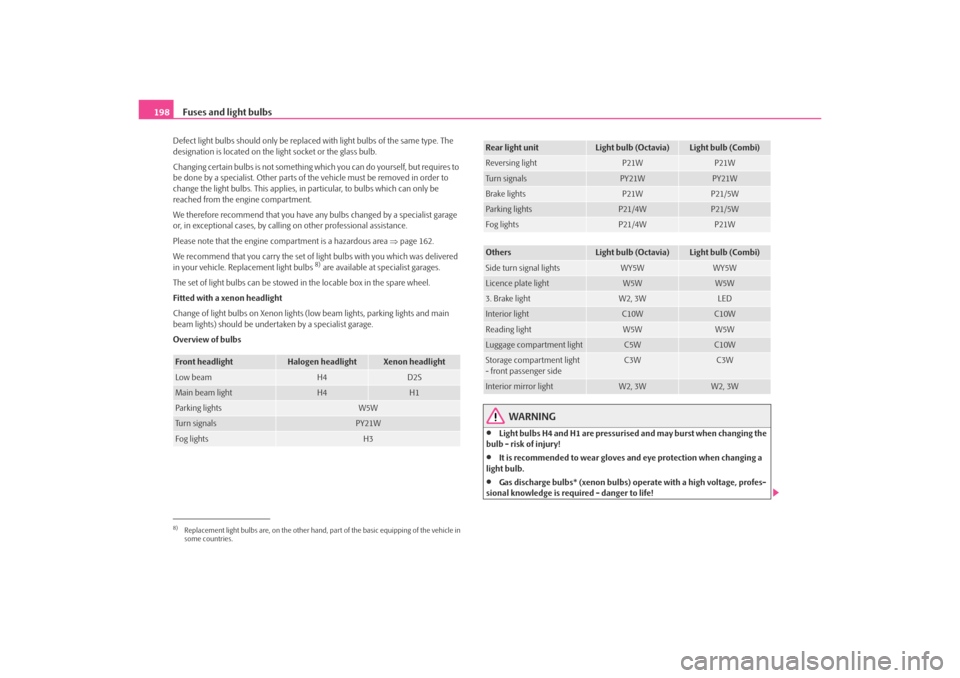
Fuses and light bulbs
198Defect light bulbs should only be replaced with light bulbs of the same type. The
designation is located on the light socket or the glass bulb.
Changing certain bulbs is not something wh ich you can do yourself, but requires to
be done by a specialist. Other parts of the vehicle must be removed in order to
change the light bulbs. This applies, in particular, to bulbs which can only be
reached from the engine compartment.
We therefore recommend that you have any bulbs changed by a specialist garage
or, in exceptional cases, by callin g on other professional assistance.
Please note that the engine compartment is a hazardous area ⇒page 162.
We recommend that you carry the set of light bulbs with you which was delivered
in your vehicle. Replacement light bulbs
8) are available at specialist garages.
The set of light bulbs can be stowed in the locable box in the spare wheel.
Fitted with a xenon headlight
Change of light bulbs on Xenon lights (low beam lights, parking lights and main
beam lights) should be undertaken by a specialist garage.
Overview of bulbs
WARNING
•
Light bulbs H4 and H1 are pressurised and may burst when changing the
bulb - risk of injury!
•
It is recommended to wear gloves an d eye protection when changing a
light bulb.
•
Gas discharge bulbs* (xenon bulbs) op erate with a high voltage, profes-
sional knowledge is requ ired - danger to life!
8)Replacement light bulbs are, on the other hand, part of the basic equipping of the vehicle in
some countries.Front headlight
Halogen headlight
Xenon headlight
Low beam
H4
D2S
Main beam light
H4
H1
Parking lights
W5W
Turn signals
PY21W
Fog lights
H3
Rear light unit
Light bulb (Octavia)
Light bulb (Combi)
Reversing light
P21W
P21W
Tu r n s i g n a l s
PY21W
PY21W
Brake lights
P21W
P21/5W
Parking lights
P21/4W
P21/5W
Fog lights
P21/4W
P21W
Others
Light bulb (Octavia)
Light bulb (Combi)
Side turn signal lights
WY5W
WY5W
Licence plate light
W5W
W5W
3. Brake light
W2, 3W
LED
Interior light
C10W
C10W
Reading light
W5W
W5W
Luggage compartment light
C5W
C10W
Storage compartment light
- front passenger side
C3W
C3W
Interior mirror light
W2, 3W
W2, 3W
s2ig.book Page 198 Monday, November 10, 2008 11:20 AM
Page 200 of 226
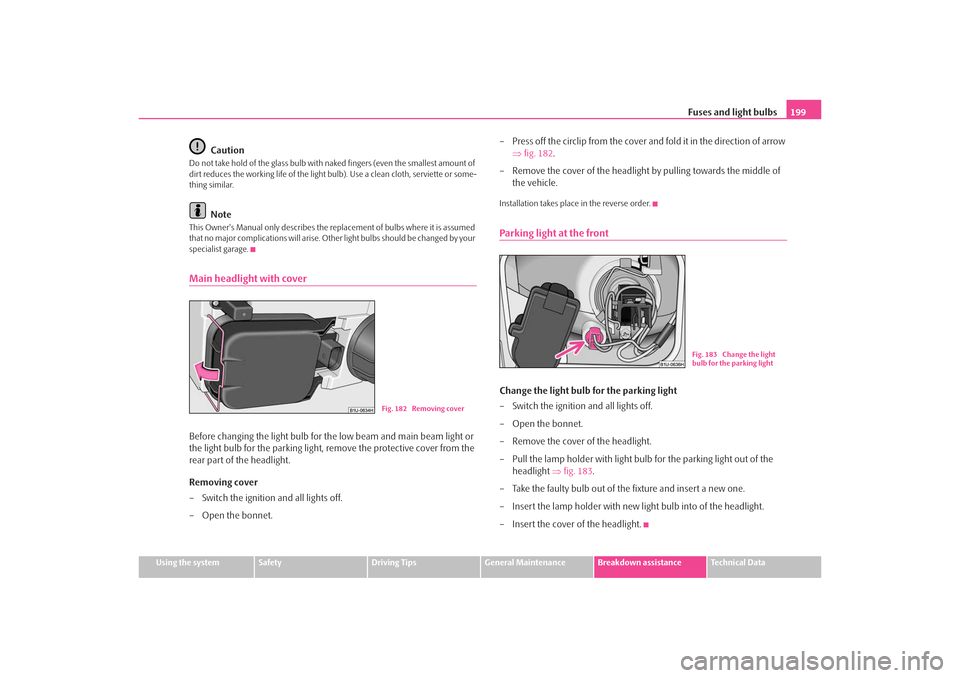
Fuses and light bulbs199
Using the system
Safety
Driving Tips
General Maintenance
Breakdown assistance
Technical Data
Caution
Do not take hold of the glass bulb with naked fingers (even the smallest amount of
dirt reduces the working life of the light bu lb). Use a clean cloth, serviette or some-
thing similar.
Note
This Owner's Manual only describes the replacement of bulbs where it is assumed
that no major complications will arise. Other light bulbs should be changed by your
specialist garage.Main headlight with coverBefore changing the light bulb for the low beam and main beam light or
the light bulb for the parking light, remove the protective cover from the
rear part of the headlight.
Removing cover
– Switch the ignition and all lights off.
– Open the bonnet. – Press off the circlip from the cover and fold it in the direction of arrow
⇒fig. 182 .
– Remove the cover of the headlight by pulling towards the middle of
the vehicle.
Installation takes place in the reverse order.Parking light at the frontChange the light bulb for the parking light
– Switch the ignition and all lights off.
– Open the bonnet.
– Remove the cover of the headlight.
– Pull the lamp holder with light bulb for the parking light out of the headlight ⇒fig. 183 .
– Take the faulty bulb out of the fixture and insert a new one.
– Insert the lamp holder with new light bulb into of the headlight.
– Insert the cover of the headlight.
Fig. 182 Removing cover
Fig. 183 Change the light
bulb for the parking light
s2ig.book Page 199 Monday, November 10, 2008 11:20 AM